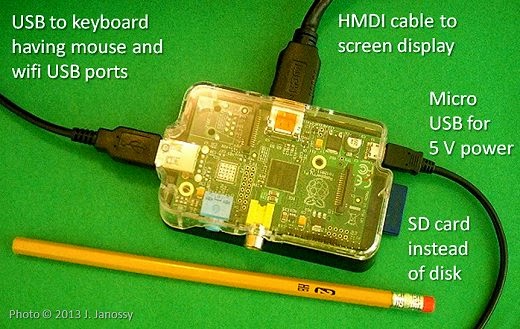I included a pencil in this photo so you could get an idea of the small size of the Pi. This "Model A" board has 256 Mb of memory and one USB connector at the left and costs $25. The "Model B" has 512 Mb of memory and two USB connectors at the left and costs $35. I experiment with the "A" just to see how far I can push things with the least expensive configuration for schools and individual learners. I use a keyboard with two USB ports on the keyboard itself, sold by Perixx.com and carried by Amazon for $15. That allows me to plug in a mouse and wifi adapter on the keyboard and this bare-bones little computer board works fine and easily connects to the internet this way. As far as I can see the "A" runs as fast as the "B" and I see no difference in the way it runs the software I am experimenting with.
What can you do with a Raspberry Pi?
This little computer does a great job running the entire LibreOffice suite (a very capable free alternative to the Microsoft Office Suite) and the highly graphic hands-on Scratch program learning environment provided free by the Massachusetts Institute of Technology. So you can use this little computer to prepare documents, slide presentations, create spreadsheets, and learn and teach programming concepts even to grammar school kids, who are engaged and kept interested by interacting with Scratch and its entertaining cartoon characters and sounds. The computer supports a .pdf reader so learning materials can be provided in electronic form. It also runs the free Python programming environment by which you can learn and accomplish real computer logic development. I have all of these applications and more on the single 8 Gb SD card plugged into this tiny device and there's still room for a lot more! It can run the GIMP digital image editor and thousands of other "packages" you download directly to it, free.
The Raspberry Pi doesn't (yet) figure in any CSC-200 assignments but I am planning to include optional coverage and use of it soon! I've included this web page here now so that students currently in the course, especially students studying to become teachers, can learn about this marvelous technological development and keep it in mind for use in classrooms. It's conceivable that a school district could provide access to these machines to each student at school and provide one to each student for home use too--giving students in poorly-funded school districts access to technology in their homes without having to spend a lot of money or worry about the loss of expensive equipment. The only thing students would need to carry between home and school is the small, inexpensive removable SD card, conveying all of their software, homework, and even reading material. Plug your SD card into a Pi anywhere and you're in business. Contrast this to the foolish scheme recently adopted by the Los Angeles Unified School District to provide an iPad to each of 655,000 public school students at a cost of over $1 billion! Carrying an expensive device like an iPad between school and home in rough and gang-infested neighborhoods puts school kids in a very dangerous situation, not to mention the huge drain it imposes on public finances in an era when the same district closes schools and lays off teachers for lack of funding. The Pi is a better solution in many ways and a much more feasible one for many schools. Someone needs to clue public school administrators and elected school board members into technology, and it perhaps has to be knowledgeable new teachers entering the field!
Interested in learning more? I have researched resources freely available on the web from www.ocr.org.uk, a unit of Cambridge University, one of many organizations supporting instruction on the Pi. You can quickly download what I think are the three of the most useful documents for beginners, to do this CLICK HERE. The 3.8 Mb zipped file you'll download from the CSC-200 site contains those three OCR publications to save you the effort of having to find them yourself.

